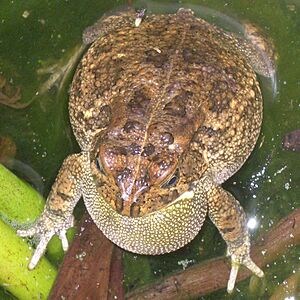Guttural toad facts for kids
Quick facts for kids Guttural toad |
|
|---|---|
|
|
|
| Conservation status | |
| Scientific classification | |
| Synonyms | |
|
Bufo gutturalis Power, 1927 |
The African common toad (also called the guttural toad) is a type of toad found in many parts of Africa. Its scientific name is Sclerophrys gutturalis. These toads live in a wide range of places, from forests and savannas to grasslands and even urban areas. You can find them near rivers, lakes, marshes, ponds, and even in gardens and canals. They are very good at adapting to different environments.
What Does It Look Like?
The guttural toad is a fairly large toad. Male toads can grow up to 90 mm (3.5 in) long, while females can reach 120 mm (4.7 in). Their skin is usually a brownish color with dark brown spots that are not always the same shape.
Look closely and you might see two pairs of brown spots between their eyes, forming a cross-like pattern. Sometimes, they also have a pale stripe running down their back. Their arms have special white bumps called tubercles along the edges. You might also spot a reddish patch on the back of their thighs. The underside of the toad is pale and bumpy, and male toads have a dark throat. They have noticeable glands behind their eyes, and their toes are only slightly webbed.
Life Cycle and Reproduction
Male guttural toads make a special sound, like a "snore," to attract females. They call out from the surface of water bodies, especially during the main breeding season in October and November. Many males can gather together, creating a loud "chorus" of calls.
Female toads lay their eggs in long, double strings. These strings are often wrapped around plants that are underwater. The baby toads, called tadpoles, grow for about 75 days. After this, they go through a process called metamorphosis. This is when they change from living in water with gills to living on land with lungs, becoming tiny toadlets. Sometimes, so many young toads leave the ponds at once that the ground can seem covered with them! Many of these young toads are eaten by other animals.
Is It Endangered?
The guttural toad is a very common species. In fact, its numbers are growing, and it is spreading across southern Africa. This is because these toads are very adaptable and can live in many different types of places. They do not have many major predators, and losing their natural habitat does not affect them much. This means they are not considered an endangered species.




